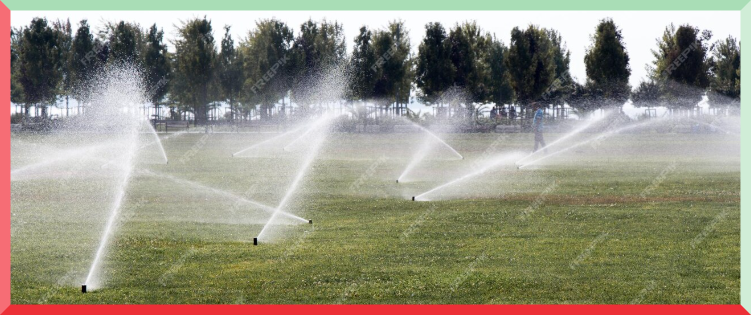
Sprinkler systems are a widely used irrigation method, perfect for everything from football fields to farmland and gardens.
Maintaining these systems is essential for efficient operation. Is your sprinkler system acting up? Don’t let a malfunctioning system turn your lush lawn into a patchy desert.
Whether you’re dealing with stuck sprinkler heads, mysterious leaks, or water pressure problems, this guide will help you troubleshoot and fix common irrigation issues—saving you time, money, and frustration.
Sprinkler Head Problem
After long term usage, sprinkler heads are exposed to harsh climate conditions or take a beating from lawn mowers, foot traffic, and general wear and tear.
Here is how to address these problems.
Stuck Heads
- Remove the head and check for debris
- Lubricate with approved sprinkler lubricant
- Replace if internal mechanisms are damaged
Misaligned Spray Patterns
- Adjust the head’s arc pattern
- Straighten tilted heads
- Clear obstacles blocking the spray
Broken or Damaged Heads
- Replace damaged components
- Consider upgrading to more durable models
- Install protective covers in high-traffic areas
Controller and Timer Issue
The controller is the brain of the operation, deciding when to start and stop irrigation. Even new smart controllers showcase more information, such as which is a crucial plant.
If the controller starts to malfunction, it wreaks havoc in your garden, especially in the hot summer when plants need water.
The first common thing you should look for:
- Incorrect time/date settings
- Improper zone run times
- Conflicting program schedules
- Forgotten seasonal adjustments
If there is no problem found, then do the Basic Troubleshooting Steps
- Verify power supply and connections
- Check for tripped circuit breakers
- Inspect wire connections
- Test backup battery
Water Pressure Issues
Both high and low water pressure hinders the sprinkler capacity.
High water pressure pressure is too high if the sprinkler heads are misting instead of spraying a steady flow. Having consistently high water pressure can wear your system out more quickly.
In low water pressure, sprinkler heads don’t fully pop out of the ground or provide poor water coverage.
Cause for this problem:
- Partially closed valve
- Clogged filters or heads
- Too many sprinklers running at once
- Underground leak
- Municipal water pressure issues
Quick Fix for the problem:
- Check and fully open all system valves
- Clean or replace clogged filters
- Inspect and clean sprinkler heads
- Adjust zone scheduling to reduce simultaneous operation
- Look for soggy spots in your yard that might indicate leaks
If you want to know precisely what causes the problem, test your water pressure using a simple pressure gauge attached to an outdoor spigot. Most residential sprinkler systems need 40-65 PSI for optimal performance.
Leaky Valves
Leakage in irrigation valves can cost you more.
Leaks can damage your landscape and home’s foundation. Here’s how to track them down:
Signs of a Leak:
- Unusually high water bills
- Wet spots between sprinkler heads
- Muddy areas or excess moss growth
- Sinking spots in your lawn
- Poor system pressure
Here are some methods to find hidden leaks
- Run each zone separately
- Walk the system while operating
- Look for unusual plant growth
- Check valve boxes fo
Leaky valves damage your system’s components. Timely maintenance and repair of valves help preserve water and the longevity of your sprinkler system.
Uneven Watering
Some areas of the lawn receive more water, while others don’t get enough. Leading to an uneven and unhealthy landscape.
The main reason for uneven watering:
- Misaligned Sprinklers
- Damaged Sprinkler.
- Clogged Sprinkler Nozzle .
Taking the time to realign or replace damaged heads and remove debris from nozzles ensures that every corner of your landscape receives the hydration it needs.
Motor Issues
If you use a motor for sprinkler irrigation, you’re likely to come across a variety of problems.
The most common one is while using a monoblock pump, debris can clog the pillar, causing low pressure for sprinklers.
Another problem is electricity, irregular power supply, leads to irregular water supply, ultimately hindering the growth of the plants.
To overcome these problems:
- Monitor the water level
- Use autostarter for automatically start the motor when electricity is available
- Take expert help with further assistance with Motors
Tools You Should Have to Troubleshoot
Have these tools for your irrigation toolkit
- Sprinkler head wrenches
- Pressure gauge
- Basic hand tools
- Spare heads and nozzles
- Wire nuts and waterproof connectors
- Pipe repair materials
Money Saving Tip
Proper maintenance and troubleshooting can save significant money:
- Regular system checks prevent costly repairs
- Smart controllers reduce water waste
- Proper winterization prevents freeze damage
- Timely repairs prevent water bill spikes
- DIY maintenance and service calls
Last Words…
Don’t let small issues ruin your irrigation system. Regular maintenance and prompt attention to problems will keep your system running efficiently and effectively.
Here are some steps you can incorporate to avoid mistakes:
- Inspect your system today
- Document any issues
- Create a maintenance schedule
- Build your tool kit
- Save professional contacts for emergencies
Start with basic troubleshooting steps, and don’t hesitate to call a professional when needed.
A well-maintained irrigation system not only saves water and money but also ensures a lush, healthy landscape.

Comments (4)
Abhisays:
February 22, 2025 at 2:10 pmIt’s awesome post, I got the detail information thanks
[email protected]says:
February 22, 2025 at 2:13 pmGlad you liked
mike manningsays:
April 28, 2025 at 4:01 pmFor all zones, sprinkler heads not popping up, but water dribbles from nozzle. Low water pressure? Home water pressure unchanged.
[email protected]says:
April 28, 2025 at 6:44 pmCheck for any leakages, and thoroughly examine sprinkler heads.